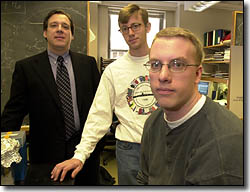Images Show DNA Repair in Action

Images of natural repairs being made on DNA damaged by oxidation have been captured by chemists at Harvard University.
The damage is an inevitable consequence of breathing. Roughly 100,000 times a day in the life of a human cell, highly reactive forms of oxygen attack DNA, thereby scrambling the genetic code. Cigarette smoke is rich in these so-called free radicals, exposing smokers lungs to a much greater intensity of attack. Fortunately, the body has a way to fix the problem.
“Its an exquisitely designed system, which recognizes the DNA damage and then cuts out the affected area,” says Gregory Verdine, professor of chemistry. “We have been able to see, for the first time, a natural antioxidant at work repairing DNA. Understanding this particular process is especially important because it has been widely implicated in human cancers.”
The same process has been implicated in aging. Mice that age prematurely possess a defective mechanism for repairing oxidized DNA. Loss of a key mending protein appears to work with other genetic factors to accelerate the journey toward death.
This protein, known as hOGG1 (pronounced “hog one”), forms a pocket that positions itself over the abnormal piece of DNA. When this occurs, chemical reactions take place that neatly cut away the problem part. “Its the kind of specific recognition and excision that gets chemists and biologists really excited,” Verdine comments.
What is cut out is a single letter of genetic code, one of some 3 billion letters arranged in pairs to form an estimated 100,000 genes that spell out every humans physical makeup. Each of us continually receives free-radical insults that damage one letter out of every 1 million to 10 million pairs. Finding such rare misspellings makes hOGG1 an extremely careful and diligent proofreader.
Collaring a Culprit
In the Feb. 24 issue of the scientific journal Nature, Verdine and graduate student Steven Bruner describe how they captured hOGG1 in the act of pocketing a damaged letter known as 8-oxoguanine ( oxoG, for short). The union was laboriously crystallized to freeze the act in time. X-rays shown through the crystal reveal, with the help of powerful computers, the position of every atom. The result has led to the first image ever captured of oxidized DNA being repaired.
Reactive compounds that arise from activated oxygen, and from exposure to radiation and tobacco smoke attack the letter G (guanine) and produce oxoG. Normally G pairs with C (cytosine). But when oxoG gets involved, it pairs with A (adenine), and this mistake can be passed along to children at the time of reproduction. The mistake is the second most common mutation found in human cancers.
“In repairing oxoG, timing is everything,” Verdine says. When hOGG1 finds oxoG paired with C it quickly corrects the damage. But if oxoG couples with A, hOGG1 no longer recognizes the misspelling. Luckily, another repair protein can replace A with C, giving hOGG1 another shot at oxoG.
Partial or complete loss of hOGG1 has been linked with lung cancer. “In 60 to 70 percent of all lung cancer, one of the genes for making the hOGG1 protein has been deleted,” Verdine explains. “For the variety known as small-cell lung cancer, its 100 percent.”
Everyone has two sets of genes, one inherited from each parent. If you lose one, you still have the other, but that gives you only half as much hOGG1 with which to repair free-radical damage. About 10 percent of lung cancer patients have no working hOGG1 genes at all, leaving them highly vulnerable to dangerous mutations.
“Absence of hOGG1 probably doesnt cause lung cancer by itself,” Verdine points out, “But its presence is likely to be important for preventing cancer in lungs continually exposed to tobacco smoke.”
A Corrupted Guardian
HOGG1 can prevent mutations, but what if the protein itself gets mutated? Graduate student Derek Norman and Verdine have found a situation where the consequences are diabolic. A hOGG1 mutant found in stomach cancer cells loses its selectivity when proofreading for an oxoG and C pairing. In its confusion, it edits out all oxoG, regardless of what letter it pairs with.
“It gains the ability to make repairs it really shouldnt make,” Verdine explains. “Its the most diabolical form of mutation you can have because hOGG1 changes from an anti-mutator into an evil twin that actually promotes mutations. Weve only found one example of this, in stomach cancer; we dont know how widespread it may be.”
Thats one area open for investigation. Another one covers the role of hOGG1 and oxoG in aging. Mice genetically disposed to premature aging have an inherited mutation that makes the protein unstable. This finding supports a long-held notion that oxidative damage, unchecked by repair, can shorten life.
That notion, however, amounts to guilt by association, not definite proof. To obtain more direct evidence, Verdine and Research Associate in Chemistry and Chemical Biology Rongzhen Lu have genetically engineered mice so they lack the hOGG1 gene, and they plan to compare the lifetimes of these mice with those of their normal relatives.
“Damage caused by oxidants and other highly reactive compounds occurs continually in all our cells,” Verdine notes. “The protein family to which hOGG1 belongs includes numerous other members that repair a wide variety of chemically distinct damage in DNA. This is fundamental biology, and we want to determine how genetic differences among people affect their ability to ward off DNA damage.”
And, of course, Verdine and other researchers want to discover how hOGG1-type proteins locate a few errors among millions of letters that spell out the code of life.




